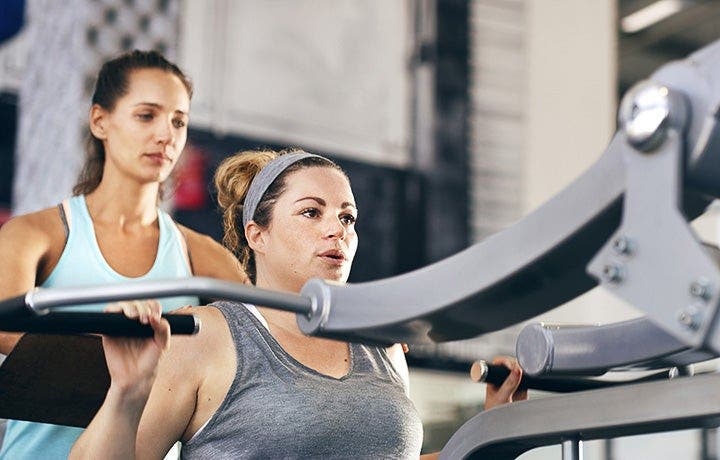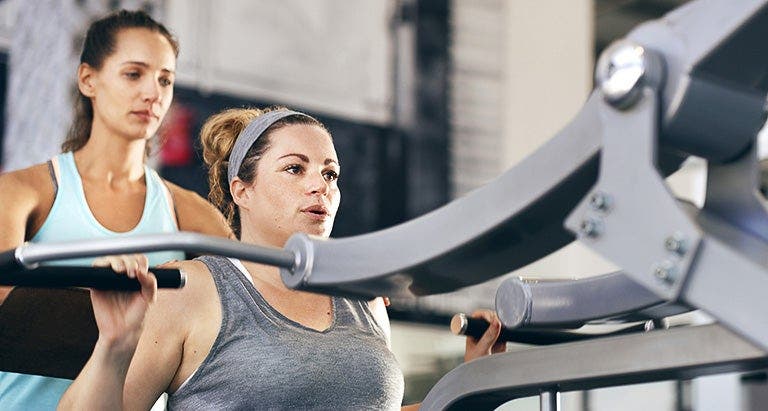6 Steps to Setting Up Gym Machines


Weight machines can be intimidating. Not only the people on them, or not knowing which machine works which muscles, but, more important, how to set it up so that you don’t injure yourself can be overwhelming. Well it’s time to stop letting weight machines at the gym intimidate you.
We asked fitness and exercise science experts for tips and tricks to help you set yourself up for success with these iron machines. To start, no matter what the machine, you should have good posture, use controlled movements, and move in a full range of motion for each and every exercise you do. Read on to broaden your workout regimen.
1. Read the machine description.
Most strength machines have a sign with the name of the machine, and a diagram explaining what the machine does. “This should give you a general idea of how to use the machine,” says Noam Tamir, CSCS, owner of TS Fitness in New York City. “In most gyms, there are trainers on the floor, too, who are happy to assist you in using the machines.”
2. Watch those around you.
It’s true, not everyone knows what they’re doing on the strength machines, but some do. If you’re a bit confused, try watching someone else using the same machine. “Observe an exerciser who isn’t heaving the weights, but is performing the exercise in a controlled manner,” says Wayne Westcott, PhD, CSCS, professor of exercise science at Quincy College in Quincy, MA. “You can even try asking them for advice on proper technique.”
RELATED: Your Guide to the Weight Room
3. Adjust the machine.
Before using any machine, it’s important to make sure it’s adjusted to your size and strength. And depending on the type of machine, the adjustments will be different. “If you are using a cable machine, you would be using an adjustment that slides up and down the cable machine,” explains Tamir. Depending on the pulley system and the make of the machine, the weights and angles can differ, so unfortunately not one setting works for all.
“For seated machines you usually want your knees at a 90-degree angle,” explains Tamir. “If there is backing to the machine, you want to be able to put the natural arch of your back against the machine.” Keep in mind, everyone's lower body and torso are going to be different lengths, so most of the time you need to see what settings are most comfortable for you and allow you to use a full range of motion. You also don't want the machine to be too restrictive or hyperextend the joints in some cases, warns Tamir.
4. Line yourself up for success.
We mean that literally. If you want to use a strength machine correctly, it’s important you line yourself up correctly in order to do so. “For rotary movements like leg extensions, leg curls, triceps extensions, biceps curls, etc., the most important factor is to place your joint axis—knee, elbow, etc.—directly in line with the machine axis of rotation, or pivot point,” explains Westcott. “For linear movements like the chest press, pull-down, leg press, etc., try to imitate the same action you would do with body weight exercises, such as push-ups, pull-ups, squats, etc.” The key is to feel the effort in the muscles that the machine targets, without feeling discomfort in any of your joints.
5. Choose the right weight.
If it’s your first time doing an exercise, you may not know where to start when it comes to weight. “For most practical purposes of health, fitness, and muscle development, use a resistance that helps you perform the exercise correctly, with controlled movement speed and full movement range for 10 to 15 repetitions, which is equivalent to 75 percent to 65 percent of your maximum resistance,” says Westcott. “When you’re able to complete 15 reps, increase the resistance by about 5 percent.”
Use sensible trial and error to determine the initial resistance that you can comfortably perform about 12 times, suggests Westcott. The good thing about machines (and even free weights) is that you can always change the weight if it’s too light or too heavy.
6. Record your workout.
Not only the exercises that you do, but you should also keep track of the adjustments you make to machines and the weight you’re using. That way, you’ll know where to start the next time you return to a machine. Plus, seeing progress can help motivate you. “I’m all about recording setting and weights,” says Tamir. “It saves you a lot of time, optimizes your workout, and helps you to progress, and it is how you get stronger and build more muscle.”
